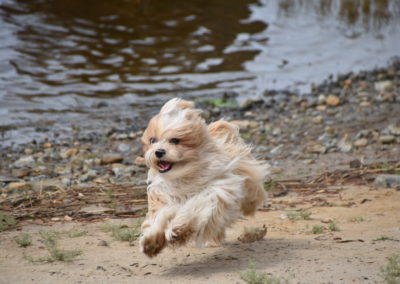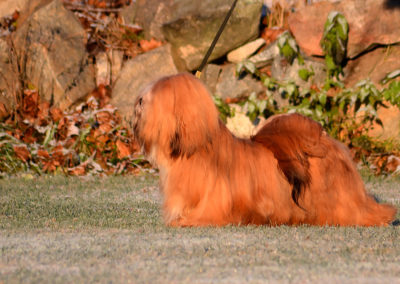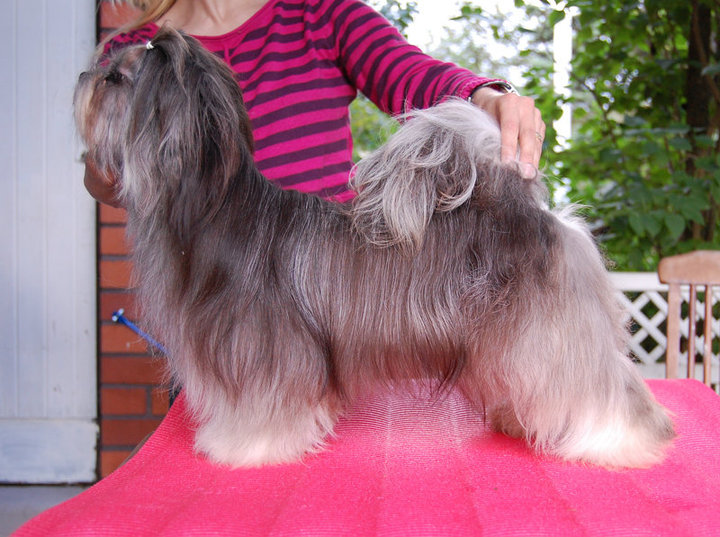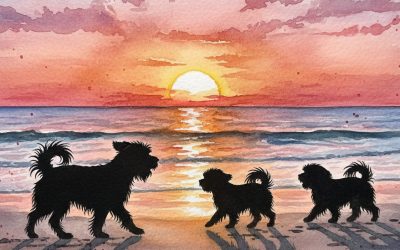Understanding the Colour Genetics of Lhasa Apsos (and Dogs in General)
The Colour Genetics of Lhasa Apsos and Dogs
Dog colour genetics are based on two fundamental base colours: black and brown. On top of these base colours, various patterns and markings can appear, creating a unique appearance for each dog. In Lhasa Apsos, the nose pigment should be black, so brown-pigmented individuals are not preferred in the breed, even though they do occur.
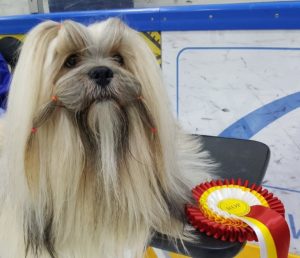 Brown Pigment vs. ‘Winter Nose’
Brown Pigment vs. ‘Winter Nose’
Brown pigment means that all pigment in the dog’s body (such as nose, eye rims, and paw pads) is brown instead of black. This differs from the so-called ‘winter nose’, where the nose is mostly black but fades to a lighter colour during the winter months due to seasonal pigment changes. A winter nose is not the same as brown pigment, as the underlying pigment remains fundamentally black.
If a dog’s base colour is brown, it can have all the same colour patterns as a dog with black base color, with the difference being that what is black on a black dog is brown on a brown dog. For example, black & tan becomes brown/liver/chocolate & tan, and in sables, the tips of the hair are brown instead of black.
Types of Colouration

CIB Ch. Yarmilan Man With No Eyes
There are two main types of colouration: particolour and solid colour. Particolour means that the dog has a white base coat with patches of any other colour. The amount of white can vary from almost completely white to about 50% white and 50% coloured. If there is less than 5% white, the dog is usually considered solid-coloured. In puppies, minor white markings can often disappear as the dog matures. There is also what is known as the Irish spotting pattern, which appears as something between particolour and solid colour. In this pattern, about 10–30% of the coat is white, and it often can be recognised by a white collar. It is inherited via a different gene than the usual particolour pattern. Based on my own observations, Irish spotting seems to be more rare in Lhasa Apsos than particolor. However, it is more common in Tibetan Terriers and, for example, various Collie breeds.
The Most Common Colours and Patterns in Lhasa Apsos
- Black: Black is a dominant colour, meaning the puppy must inherit black from at least one parent to display black coat colour.
- Black with markings: Black & tan, Black & Silver, etc. These dogs have lighter markings on the head, legs, chest, and under the tail. The colour of the markings can range from dark red to pale silver. This pattern is inherited recessively, so both parents must carry the gene, even if they themselves are light in colour. Sometimes, the markings are so minimal that the dog appears almost entirely black, especially if it also has a black mask. Then usually you can look at the tail and under the tail. That will reveal if a dog is black & tan/silver unless it’s a particolor and the white part is masking the tan/silver markings.
- Saddle pattern: Well-known from German Shepherds, saddle pattern forms a black saddle or mantle over the back, with lighter colouring elsewhere. These can born as a black & tan but the tanmarkings will get larger by age.
- Sable: The most common colour in Lhasa Apsos, ranging from nearly white to almost black. Sables have a light base colour with black tips on the hair. The amount of black tipping determines how dark the sable appears, and the colour can change throughout the dog’s life. The base color can vary from deep red to almost white cream. The darkest sables can appear almost like black and the lightest ones almost whites, but most of the Lhasa Apsos are something in between. Often you can see tan markings also on sables, especially on the darker ones.
- Cream, gold, and red: These are rarer than sables, and have no black tipping on the coat. The shades may lighten or darken with age, and hormones or nutrition can also affect the intensity of the colour. These can also vary from very deep red to white. Often the lighter creams have difficult on keeping their nose black, they often fade to brown, even if the dog’s basic color is black instead of brown.
- Brindle (striped): Brindle puppies have visible black stripes on their base colour. The pattern changes dramatically as the coat grows, and adult brindles often look much darker. Often you can see that the brindle puppy becomes first quite light grey as it turnes into youngster and when years go by towards veteran classes, the dog will turn almost black.
- Mask: A black mask is common in Lhasa Apsos, starting from the nose and sometimes extending over the whole head or to the legs, depending on its intensity.
- Diluting gene: A diluting gene can make the coat colour fade as the dog ages, especially in black dogs, but sables and reds can also lighten over time with this gene.
- Ticking or roan: White areas may develop spots or ticking, which can increase with age. In some cases, the dog may look almost solid grey or spotted, similar to a Dalmatian, especially if the coat is clipped short.
Some Lhasa Apsos are registered as grizzle in colour, but this is not genetically found in the breed. In reality, these dogs are either sable or have a saddle pattern, whose appearance is similar to grizzle.
These are the most common colours and patterns found in Lhasa Apsos. If you notice any significant colour or pattern missing from this article, I will be happy to update the text to include it.
A gallery of some of our different colors here at Yarmilan kennel
Some of the dogs we have owned, bred or had visiting at our home <3
Golden sable CIB Multi Ch. Yarmilan Murphy’s Irish Red
Ebba’s sire CIB Multi Ch. Yarmilan Murphy’s Irish Red
Interested in a Puppy?
If you are interested in our upcoming litter or another co-owning option, feel free to reach out: yarmilan@gmail.com
Or leave a message
Previous blog posts
DNA-testing of dogs is often misunderstood
DNA Testing in Dogs – A Breeder’s Perspective I’ve been involved with canine DNA testing since the late 1990s, back when the first test for copper toxicosis became available for Bedlington Terriers. It was a groundbreaking moment: suddenly, we had a tool to identify...
The Hardest Part of Loving Dogs
Breeding and owning dogs is a journey filled with joy, laughter, and countless cherished memories. But alongside all the wonderful moments comes one of the hardest truths we dog lovers must face: saying goodbye.
This summer has been especially difficult for us at Yarmilan. Within just one month, we had to part with three beloved members of our family.
Back to the Agility Ring After 17 Years – with a Lhasa Apso in Heat!
I started agility back in the late 1990s with my Chinese Crested Powder Puff, Iiro. But it was my white poodles, Viivi (medium) and Ville (miniature), that really got me into the competition scene. Both made it all the way to class 3, and Ville was an absolute rocket...


